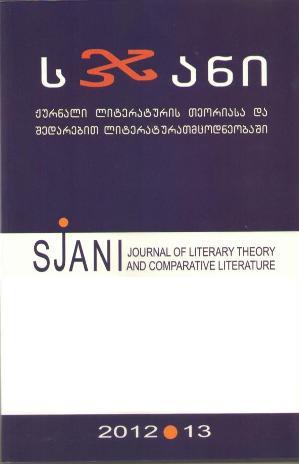მოდერნიზმის ეპოქა, როგორც მითოსს მოკლებული დრო კონსტანტინე გამსახურდიას რომანში "დიონისოს ღიმილი"
Modernism as a Mythless Age in Konstantine Gamsakhurdia’s Novel “The Smile of Dionysus”
Author(s): Konstantine BregadzeSubject(s): Literary Texts
Published by: ლიტერატურის ინსტიტუტის გამომცემლობა
Keywords: mythos; modernism; mythless age.
Summary/Abstract: In the 20s of the 20th century Konstantine Gamsakhurdia (1891-1975) defined modernism as a mythless age (cf. the essay “Literary Paris”), therefore metaphorically indicating the spiritual crisis of the epoch. It implied the presence of the existential human fear, his alienation with metaphysical-mythic prototype, the impossibility of self-identification and dehumanization. On the one hand, historical processes and cataclysms – total development of technical civilization, world war and revolutions and, on the other hand, fundamental metaphysical “quake”, which Nietzsche called the death of God and revaluation of values provoked the above mentioned consequences. Correspondingly, western as well as Georgian modernistic literature highlighted the quest for an exit route of a human’s spiritual-cultural crisis and therefore acquisition of sense to his existence. From this standpoint, it is worth mentioning German researcher’s modernizmis epoqa, rogorc miToss moklebuli dro, konstantine gamsaxurdias romanSi `dionisos Rimili~ 86 Silvio Vietta’s study: “Reflection of social changes – industrialization, urbanization, new forms of communication (telephone, telegraph, railway and vehicles), new forms of media (radio, newspapers) – do not represent the main issues of a modernistic novel. The questions that are raised here are completely different: the problem of modern subjectivity in society, its inner split and collapse in modernism. The instability of mentality is unveiled, an inevitable historical process peculiar for modernism” (see S. Vietta, “European Modernistic Novel” // S. Vietta, “Der europäische Roman der Moderne, München, 2007. S. 20-21). K. Gamsakhurdia’s “The Smile of Dionysus” (1924-1925) is a typical modernistic literary text, with its discourse emphasizing existential and spiritual crisis of a modernist human being. Simultaneously, an attempt is made to overcome the existential crisis provoked by the death of God – an unsuccessful attempt to reanimate Dionysus’ aesthetic culture – ending in failure hence demonstrating human’s existential lack of prospects in the epoch of modernism (“you are lying in a cold grave and the soul is sad”). In modernistic texts are mythological paradigms integrated (i.e. J, Joyce “Ulysses”. Gr. Robakidze’s “Snake Skin” and others), where those paradigms have double meaning: on the one hand, purely poetical-aesthetic, when mythical paradigms form compositional, narrative and imagological foundations of a text, and, on the other hand, purely ideological, when an author uses myth as means for overcoming crisis (i.e. Gr. Robakidze’s novel “Snake Skin”). From this standpoint, K. Gamsakhurdia’s “The Smile of Dionysus” is no exception. Mythical paradigms and imagology having double meaning are also represented in the text: on the one hand (Dionysian) myth, as a foundation for text composition, narrative line and imagology and, on the other hand, (Dionysian) myth as an ideological found
Journal: სჯანი
- Issue Year: 2012
- Issue No: 13
- Page Range: 66-86
- Page Count: 21
- Language: Georgian

